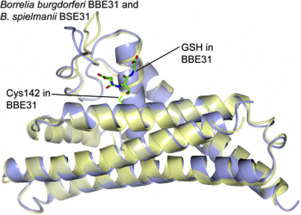当前位置:
X-MOL 学术
›
BBA Gen. Subj.
›
论文详情
Our official English website, www.x-mol.net, welcomes your
feedback! (Note: you will need to create a separate account there.)
BBE31 from the Lyme disease agent Borrelia burgdorferi, known to play an important role in successful colonization of the mammalian host, shows the ability to bind glutathione.
Biochimica et Biophysica Acta (BBA) - General Subjects ( IF 2.8 ) Pub Date : 2019-11-27 , DOI: 10.1016/j.bbagen.2019.129499 Kalvis Brangulis 1 , Inara Akopjana 2 , Ivars Petrovskis 2 , Andris Kazaks 2 , Diana Zelencova 3 , Atis Jekabsons 3 , Kristaps Jaudzems 4 , Kaspars Tars 5
Biochimica et Biophysica Acta (BBA) - General Subjects ( IF 2.8 ) Pub Date : 2019-11-27 , DOI: 10.1016/j.bbagen.2019.129499 Kalvis Brangulis 1 , Inara Akopjana 2 , Ivars Petrovskis 2 , Andris Kazaks 2 , Diana Zelencova 3 , Atis Jekabsons 3 , Kristaps Jaudzems 4 , Kaspars Tars 5
Affiliation

|
Lyme disease is a tick-borne infection caused by Borrelia burgdorferi sensu lato complex spirochetes. The spirochete is located in the gut of the tick; as the infected tick starts the blood meal, the spirochete must travel through the hemolymph to the salivary glands, where it can spread to and infect the new host organism. In this study, we determined the crystal structures of the key outer surface protein BBE31 from B. burgdorferi and its orthologous protein BSE31 (BSPA14S_RS05060 gene product) from B. spielmanii. BBE31 is known to be important for the transfer of B. burgdorferi from the gut to the hemolymph in the tick after a tick bite. While BBE31 exerts its function by interacting with the Ixodes scapularis tick gut protein TRE31, structural and mass spectrometry data revealed that BBE31 has a glutathione (GSH) covalently attached to Cys142 suggesting that the protein may have acquired some additional functions in contrast to its orthologous protein BSE31, which lacks any interactions with GSH. In the current study, in addition to analyzing the potential reasons for GSH binding, the three-dimensional structure of BBE31 provides new insights into the molecular details of the transmission process as the protein plays an important role in the initial phase before the spirochete is physically transferred to the new host. This knowledge will be potentially used for the development of new strategies to fight against Lyme disease.
中文翻译:

来自莱姆病病原体伯氏疏螺旋体的BBE31,已知在哺乳动物宿主成功定殖中起重要作用,显示出结合谷胱甘肽的能力。
莱姆病是由博氏疏螺旋体复合螺旋体引起的tick传播感染。螺旋体位于壁虱的肠内。当被感染的tick开始进食血粉时,螺旋体必须穿过血淋巴到达唾液腺,然后在唾液腺中传播并感染新的宿主生物。在这项研究中,我们确定了来自B. burgdorferi的关键外表面蛋白BBE31的晶体结构和来自B. spielmanii的直系同源蛋白BSE31(BSPA14S_RS05060基因产物)的晶体结构。已知BBE31对于在a虫叮咬后将B. burgdorferi从肠道转移到the中的血淋巴很重要。尽管BBE31通过与肩x突tick肠蛋白TRE31相互作用来发挥其功能,结构和质谱数据表明,BBE31具有与Cys142共价连接的谷胱甘肽(GSH),这表明该蛋白与其直系同源蛋白BSE31缺乏任何相互作用,与它的直系同源蛋白BSE31相反。在当前的研究中,除了分析GSH结合的潜在原因外,BBE31的三维结构还为传播过程的分子细节提供了新见解,因为蛋白质在螺旋体物理上处于初始阶段起着重要作用。转移到新主机。这些知识将潜在地用于开发新的策略来对抗莱姆病。缺乏与GSH的任何互动。在当前的研究中,除了分析GSH结合的潜在原因外,BBE31的三维结构还为传播过程的分子细节提供了新见解,因为蛋白质在螺旋体物理上处于初始阶段起着重要作用。转移到新主机。这些知识将潜在地用于开发新的策略来对抗莱姆病。缺乏与GSH的任何互动。在当前的研究中,除了分析GSH结合的潜在原因外,BBE31的三维结构还为传播过程的分子细节提供了新见解,因为蛋白质在螺旋体物理上处于初始阶段起着重要作用。转移到新主机。这些知识将潜在地用于开发新的策略来对抗莱姆病。
更新日期:2019-11-28
中文翻译:

来自莱姆病病原体伯氏疏螺旋体的BBE31,已知在哺乳动物宿主成功定殖中起重要作用,显示出结合谷胱甘肽的能力。
莱姆病是由博氏疏螺旋体复合螺旋体引起的tick传播感染。螺旋体位于壁虱的肠内。当被感染的tick开始进食血粉时,螺旋体必须穿过血淋巴到达唾液腺,然后在唾液腺中传播并感染新的宿主生物。在这项研究中,我们确定了来自B. burgdorferi的关键外表面蛋白BBE31的晶体结构和来自B. spielmanii的直系同源蛋白BSE31(BSPA14S_RS05060基因产物)的晶体结构。已知BBE31对于在a虫叮咬后将B. burgdorferi从肠道转移到the中的血淋巴很重要。尽管BBE31通过与肩x突tick肠蛋白TRE31相互作用来发挥其功能,结构和质谱数据表明,BBE31具有与Cys142共价连接的谷胱甘肽(GSH),这表明该蛋白与其直系同源蛋白BSE31缺乏任何相互作用,与它的直系同源蛋白BSE31相反。在当前的研究中,除了分析GSH结合的潜在原因外,BBE31的三维结构还为传播过程的分子细节提供了新见解,因为蛋白质在螺旋体物理上处于初始阶段起着重要作用。转移到新主机。这些知识将潜在地用于开发新的策略来对抗莱姆病。缺乏与GSH的任何互动。在当前的研究中,除了分析GSH结合的潜在原因外,BBE31的三维结构还为传播过程的分子细节提供了新见解,因为蛋白质在螺旋体物理上处于初始阶段起着重要作用。转移到新主机。这些知识将潜在地用于开发新的策略来对抗莱姆病。缺乏与GSH的任何互动。在当前的研究中,除了分析GSH结合的潜在原因外,BBE31的三维结构还为传播过程的分子细节提供了新见解,因为蛋白质在螺旋体物理上处于初始阶段起着重要作用。转移到新主机。这些知识将潜在地用于开发新的策略来对抗莱姆病。











































 京公网安备 11010802027423号
京公网安备 11010802027423号